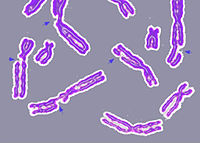
Photo from wikipedia
Telomeres are prone to damage inflicted by reactive oxygen species (ROS). Oxidized telomeric DNA and nucleotide substrates inhibit telomerase, causing telomere shortening. In addition, ROS can induce telomeric single-strand DNA… Click to show full abstract
Telomeres are prone to damage inflicted by reactive oxygen species (ROS). Oxidized telomeric DNA and nucleotide substrates inhibit telomerase, causing telomere shortening. In addition, ROS can induce telomeric single-strand DNA breaks (SSBs). The peroxiredoxin-PRDX1 is enriched in telomeric chromatin and this counteracts ROS-induced telomere damage. Here, we identify DNA processing after oxidative stress as a main source of telomeric DNA cleavage events in the absence of PRDX1. In PRDX1-depleted cells, poly(ADP-ribose) polymerase (PARP)-dependent telomeric repair is often incomplete, giving persistent SSBs that are converted into telomeric double-strand breaks during replication, leading to rapid telomere shortening. Interestingly, PARP1 inhibition dampens telomere shortening, triggering stabilization of the homologous recombination (HR) factor BRCA1 and RAD51-mediated repair of telomeres. Overall, our results reveal that, in the absence PRDX1, incomplete PARP1-dependent DNA repair and competition between PARP1 and HR cause ROS-induced telomeric catastrophe.
Journal Title: Cell reports
Year Published: 2020
Link to full text (if available)
Share on Social Media: Sign Up to like & get
recommendations!